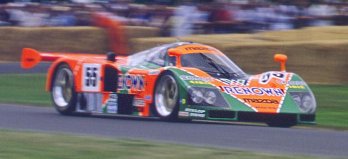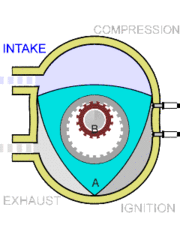The 1991 Le Mans Mazda Team and the legendary rotary «Renown» 787B.

In 1991, Mazda became the first and only Japanese car manufacturer to win the prestigous 24 Hours of Le Mans endurance race. Using the Wankel rotary engine, it was also the only non-piston engine car to ever win. All three Mazda 787B cars to enter the race finished the gruelling event in respectable 1st, 6th and 8th positions. Of a total of 46 entrants, only 12 cars officially finished the race, 4 did not make the required classification, 22 did not finish, while the remaining eight either failed to start or qualify.
 So successful was Mazda’s entry in the 1991 race that the rules for subsequent races were changed to ban the rotary engine from competing in subsequent Le Mans endurance races. At the end of the season, the FIA (Federation Internationale de l’Automobile) banned the use of Wankel-type rotary engines in the racing series which it governed to solely allow cars with the 3.5L F1 engine to compete.
1991 was the first, last, and only time that a Japanese car has won the 24 Hours of LeMans. The victory sealed the 787B’s status as an icon with Mazda fans throughout the world. Despite the enormous success of the 787B and its Wankel powerplant, Mazda didn’t fully exploit its historic victory through marketing campaigns and advertising. However it did strengthen sales partially for Mazda’s road cars…
Simplicity of design:

The powerplant:
It used a 4-rotor R26B Wankel engine which produced over 700 hp (522 kW). Engine speed (RPM’s) were deliberately kept low for longevity under the extreme stresses incurred during a 24-hour endurance race. The 787 was reported to have a redline around 9000rpm. However, interviews with Mazda’s 787 race engineers revealed that the power of the quad-rotor increased dramatically above 9000rpm. One engineer stated that the car could develop more than 930hp with a redline around 10,500rpm.
Engineers also commented that during the post-race inspection and tear-down of the quad-rotor engine they discovered that all aspects of the engine were still in excellent condition and could have run another 24-hour race.
«I kept seeing this bumble bee appear in my rearview mirror,» – Davy Jones, one of the TWR Jaguar drivers, of the Mazda.
Advantages of the Rotary Engine:
Wankel engines have several major advantages over reciprocating piston designs, in addition to having higher output for similar displacement and physical size. Wankel engines are considerably simpler and contain far fewer moving parts. For instance, because valving is accomplished by simple ports cut into the walls of the rotor housing, they have no valves or complex valve trains; in addition, since the rotor is geared directly to the output shaft, there is no need for connecting rods, a conventional crankshaft, crankshaft balance weights, etc.
The elimination of these parts not only makes a Wankel engine much lighter (typically half that of a conventional engine of equivalent power), but it also completely eliminates the reciprocating mass of a piston engine with its internal strain and inherent vibration due to repeated acceleration and deceleration, producing not only a smoother flow of power but also the ability to produce more power by running at higher rpm.
Design Parameters:
The R26B Wankel engine benefited from a variable intake system, optimizing air intake for certain vehicle speeds. Two periscope-shaped air intakes were mounted ahead of the rear wing. Each intake assembly was mated to a telescoping-pulley system which was able to vary the height of the protruding periscopes through a stroke of approximately six inches. The extension and retraction of the intakes was governed by the car’s ECU computer depending on vehicle speed. At high speed, the intakes were retracted to decrease drag and smooth airflow over the rear wing, and to reduce the restrictions on the air flow into the engine. At lower speeds, the intakes were extended in order to provide maximum positive pressure to the charge entering the rotors. Also, it benefited from an extra spark plug on each rotor from the 767’s two, making the car more economical and improving combustion. An oil cooler was mounted at the front and the car’s aerodynamics was improved at the sides and top of the bodywork. Like all previous engine, it featured Peripheral Porting in order to achieve the high levels of power from a naturally aspirated motor.
Chassis/Body
- Chassis construction: carbon composite monocoque
- Body construction: Kevlar/carbonfibre composite
- Weight: 830Â kg (1831Â lb)
- Wheelbase: 2662Â mm
- Height: 1003Â mm
- Length: 4782Â mm
- Width: 1994Â mm
- Track (F/R): 1534/1504Â mm
- Wheels: 18Â in x 12Â in front/18Â in x 14.75Â in rear Volk racing Magnesium Alloy
- Tires (F/R): Dunlop 300-640×18/355-710×18
- Suspension: front-Double Wishbone pullrod operated inboard Bilstein spring dampers, rear: top rocker-operated inboard spring dampers
- Brakes: Carbon Industries outboard ventilated 14inch carbon discs and callipers
- Lighting: 2 Cibie headlights on each side
Engine:
- Engine capacity: 654cc x 4
- Â : 5 plain main bearings
- Spark plugs: 3 NGK spark plugs per rotor
- Fuel system: Nippon Denso electronic fuel injection
- Battery: Pulsar
- Gearbox: Mazda/Porsche 5 speed
- Maximum Power: 700Â hp/9000Â rpm
- Maximum Torque: 448Â ft.lb/6500Â rpm



I hope Mazda will compite, and win, again with rotary engine in Le Mans.